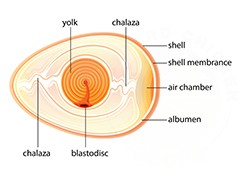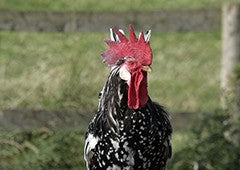If you’re a seasoned chicken owner you will know by now that no two eggs are the same. They range in size, colour and shape, and sometimes you may even come across what we like to call an ‘egg oddity’, that will often leave you scratching your head.
However, these seemingly strange occurrences can be explained, so read on below to solve the mystery of your out of the ordinary egg.
Body-Checked Eggs
Body-checked eggs are those that are wrinkled or checked in appearance. This is due to them previously being damaged while in the shell gland pouch, often from stress or pressure put on them. They are then repaired prior to lay, which is what gives them their slightly rippled appearance.
Shell-Less or Thin-Shelled Eggs
While this sort of egg may look alarming, a shell-less egg is a seemingly common occurrence, especially in young layers, as their systems are still warming up to the laying process and their shell gland is still maturing. However, if shell-less eggs are occurring in your older girls, it may be a sign of calcium deficiency (and overall poor nutrition), stress, infectious bronchitis, or EDS (egg drop syndrome). If this becomes a repeat issue, make sure your chickens are comfortable and eating a well-balanced, calcium rich diet. A quick trip to the vet to check for any further health issues won’t hurt either!
Flat-Sided Eggs
Also known as “slab-sided”, these eggs appear to have a somewhat flattened side with wrinkled edging, and are more common in young layers. It gets its misshapen appearance from being kept too long in the shell gland, or in some cases when a mis-timed egg proceeds down the oviduct and ends up resting alongside it.
Rough Shelled or Pimpled Eggs
Eggs that have differing textures can be due to a range of things. Small bead like growths on an egg (can be in a cluster or larger mole shapes), are known as calcified material and can be a result of excess calcium intake, disease, or defective shell glands. If these types of eggs are only found infrequently, there is no cause for concern, however reducing calcium intake over winter can help keep pimpled eggs at bay.
Unevenly Coloured Eggs
Uneven shell colouring are simply the result of uneven pigmentation while in the shell gland pouch-no cause for alarm!
Egg Within an Egg
Theres nothing more alarming than cracking an egg into your frypan and seeing there is another whole egg inside of it! But consider yourself lucky if this happens to you, as it is an incredibly rare occurrence! Known as counter-peristalsis contraction, this bizarre event is caused by the early release of a new yolk while an existing egg is still in the formation stage and not yet been laid. This then causes a contraction where two eggs meet up in the reproductive tract and are given a layer of albumin, membranes and a shell enclosing them both before being laid! While this may seem disturbing to some, it does not in any way mean your chicken is unhealthy.
Blood Spots
Blood spots can appear on the surface of an egg yolk and is the direct result of a blood vessel breaking in the ovary as the yolk is being released, or in the oviduct as the yolk travels through it. They occur more so in older chickens that have a genetic predisposition, are deficient in Vitamin A, or can also be a completely random occurrence!
Dwarf Eggs/No Yolk
Also known as “rooster eggs” or “wind eggs”, super small and yolkless eggs are often produced by young layers with an immature or non-synchronized reproductive system. Or in an older hen, as the result of a piece of tissue from the reproductive tract breaking off and being treated as an egg. They have the exact appearance of an egg, complete with a shell, but without a yolk-what a joke!
Double Yolks
Our favourite type of eggs-double yolkers occur when two separate egg yolks are released into our girl’s oviduct too close together, and so end up becoming encased in the one shell. This can be due to a hormonal change or imbalance that releases the yolk too early. Double-yolked eggs are more commonly produced by new layers, or those nearing the end of their laying life, and is often a hereditary trait. These eggs are generally much physically larger than normal eggs to accommodate two yolks, and doubly yum!
These are just some of the more well known ‘egg oddities’, if you have experience any out of the ordinary eggs we’d love to hear!
If you are concerned about continual or repeat issues with your eggs, it is best to visit your local vet to check over your chickens health.
All eggs are egg-straordinary and one of the biggest benefits of keeping chickens is having a great supply of fresh eggs. Nothing beats having home-laid eggs in the house for delicious meals and baking treats. However, in order to get a frequent, fresh supply of eggs, keepers need to look after the chickens that lay them. There can be multiple issues that are stopping your ladies from laying which is stressful for them and for you!
Don’t worry though – the eggsperts at Chickenpedia have cracked it! They have created the Eggs in Your Basket course to help you, help your ladies lay successfully. Discover crucial information to keep your chickens happy, healthy, and frequent layers. All your egg questions will be answered in this extensive course.
From double yolkers, to soft shells, no eggs, to odd eggs, Chickenpedia cover it all! Check out their great beginner-friendly courses today.


















